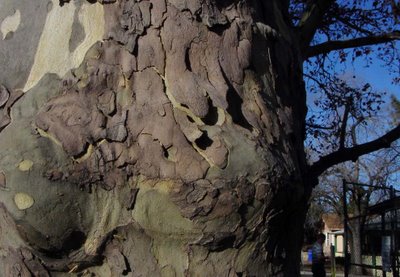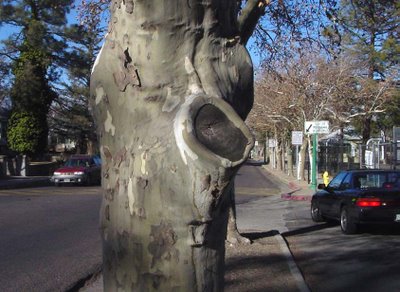 Ariaona sycamores may well be the most beautiful trees in the state. Their press, though, doesn't compare to, say, cottonwood/willows or aspens or any evergreen. On the other hand, they were well appreciated by earlier Prescott residents and city fathers. Take a look around the Sharlot Hall Museum grounds or Mt. Vernon Street or Park Avenue to see some of the city's wonderful, huge old sycamores. Here's an example, along the street in front of Lincoln School (above.)
Ariaona sycamores may well be the most beautiful trees in the state. Their press, though, doesn't compare to, say, cottonwood/willows or aspens or any evergreen. On the other hand, they were well appreciated by earlier Prescott residents and city fathers. Take a look around the Sharlot Hall Museum grounds or Mt. Vernon Street or Park Avenue to see some of the city's wonderful, huge old sycamores. Here's an example, along the street in front of Lincoln School (above.) Did you notice that the trees still retain some of their rust-colored leaves? That's one distinguishing feature of sycamores in winter. I noticed another on a recent walk -- there were some very white splotches on the trunks, visible roots (above), and limbs (below.)
Did you notice that the trees still retain some of their rust-colored leaves? That's one distinguishing feature of sycamores in winter. I noticed another on a recent walk -- there were some very white splotches on the trunks, visible roots (above), and limbs (below.)
 I suppose that there must have been a lot of peeling bark recently, to produce those white patches. (But I didn't see any bark on the ground -- wonder where it went and when...)
I suppose that there must have been a lot of peeling bark recently, to produce those white patches. (But I didn't see any bark on the ground -- wonder where it went and when...) Another distinguishing feature of the winter sycamore: plenty of pom-pom seed balls that resemble Christmas tree ornaments.
Another distinguishing feature of the winter sycamore: plenty of pom-pom seed balls that resemble Christmas tree ornaments. Apparently the Lincoln School sycamores have a history. The plaque above is modest in size and easy to miss. However, it suggests a civic battle between the road builders, with visions of widening a major thoroughfare, and neighborhood preservationists, led by one Herschel Linsky. (No, The Google has never heard of Mr. Linsky. I enquired.)
Apparently the Lincoln School sycamores have a history. The plaque above is modest in size and easy to miss. However, it suggests a civic battle between the road builders, with visions of widening a major thoroughfare, and neighborhood preservationists, led by one Herschel Linsky. (No, The Google has never heard of Mr. Linsky. I enquired.) The trees stretch from the south end of the school ground along Park Avenue...
The trees stretch from the south end of the school ground along Park Avenue... ...north to the Beach Street intersection, where the buses load and unload school kids.
...north to the Beach Street intersection, where the buses load and unload school kids. This view, looking north, shows how one group of trees was rescued by creating a special lane for what my daughter calls the "Mommy brigade" of cars waiting for children every afternoon. Note the resulting jog in Park Avenue at this point. By the way, I believe that Coronado Street used to go through what is now the middle of the school yard. So: yes, changes are made -- but once in a while, a few handsome trees are saved from the planners' zeal.
This view, looking north, shows how one group of trees was rescued by creating a special lane for what my daughter calls the "Mommy brigade" of cars waiting for children every afternoon. Note the resulting jog in Park Avenue at this point. By the way, I believe that Coronado Street used to go through what is now the middle of the school yard. So: yes, changes are made -- but once in a while, a few handsome trees are saved from the planners' zeal.Welcome, visitors from the Festival of the Trees. We have some wonderful trees here in the mountains of Arizona; I've written about several of the different kinds at one time and another. For a look, just click on the label "trees" below.





7 comments:
The trees are almost a nice as the ones the woodpeckers stick their acorns in.
You should see the sycamores that grow along lower elevation water courses -- some are giants. Actually, famous Oak Creek Canyon's major trees are sycamores, but I guess that Sycamore Canyon next door got the name first.
Here in hot southern Arizona, our Arizona Sycamores grow in canyons along streams where they can get enough water. You are right, they are beautiful trees, especially in the winter when their ghostly white bark is revealed.
I wish I could locate the reference -- however, as I recall, it said that the Salt River in the Valley of the Sun (to use their term) used to be lined with sycamores. I always recall this when I read one more environmental writer talking about the cottonwood/willow association. For some reason, sycamores are not in their world picture. Pity! I really realized that sycamores are semi-desert trees when I saw the woods in the water course of the San Jacinto River while visiting Hemet.
Oops! In Southern California, of course.
Thanks for this blog entry, J. I'm always fascinated by the individuals that formed our town in smaller ways. I find myself really wanting to know about Herschel Linsky.
many, many thanks for your interesting writing!
I suppose the Courier morgue is the place to look -- but I've absolutely no idea what year. At Google there was absolutely nada. And I think that the Sharlot Hall on-line stuff is all checked out by The Google.
Post a Comment